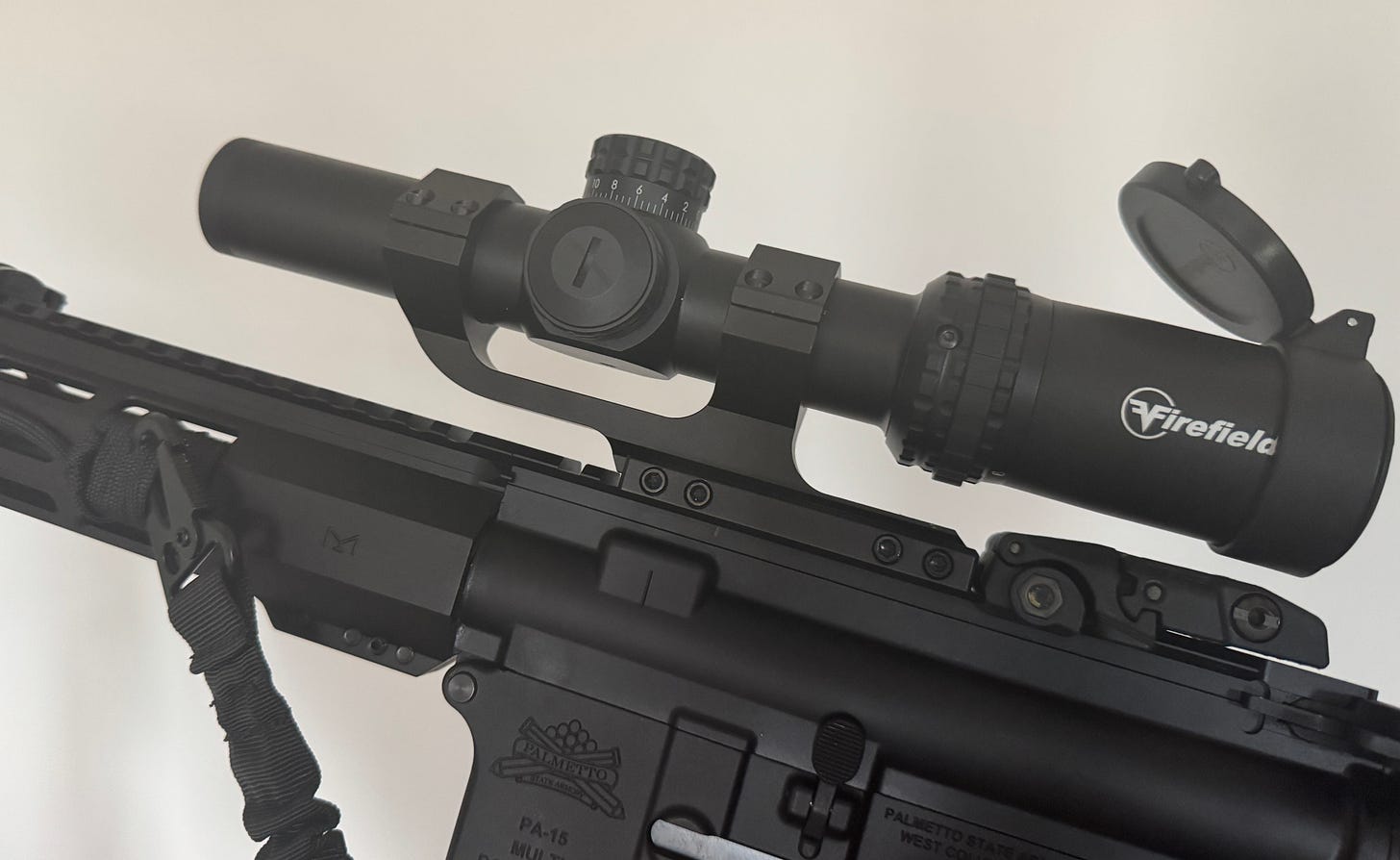The Modern Musket
My personal “Everything Rifle”
We celebrate the 250th anniversary of the battle of Lexington and Concord when colonists took arms and began the war that created the United States of America. That paired with….all of (waves hands around)…this. Gives me a good reason to consider what my ancestor, Israel Bissell had above the fireplace, and what I should have in its place a couple of centuries later.
As the world continues to turn at an alarming rate and folks begin to squabble about the rifle to have when the world gets squirrely, it gets most of us thinking about what we would want to have when everything goes pearshaped. If you were to survey American gun owners, writers, and survivalist-minded individuals with the question of what is the one rifle you would want to keep with you, the answer would likely be an AR15. The ubiquitous autoloader that, over the last half a century, has been used by most of the world as a military/ and police arm and is without question the most popular long arm in the country.
The concept of an everything rifle or SHTF rifle is universal. My "build" is not the be-all and end-all, but it's what I have chosen with a fair amount of consideration. Navigating the hundreds of options and thousands of combinations. I'll give you my reasoning behind these options.
The Builder
I went with a Palmetto State Armory rifle. Indeed, there are several great rifle companies that come in at a higher price point. I selected a rifle that retails for around 800 but was on sale for a little over 500. This price point has some other budget options that could have been selected, too. However, I've had great experiences with PSA, and I firmly believe that they have armed more Americans than any other company since Colt created the peacemaker.
The rifle lower sports an enlarged trigger guard, which is a boon for shooting with gloves. On "standard" lowers, it is possible to drift the pin which holds the trigger guard in place, but it’s not that safe an option.
The caliber
5.56 is the caliber for the AR. While there are barrels and bolts to run everything from .22lr to .50 and even 410 shotshells, almost none of them can cover the variety of uses the 5.56 will. From ultralight varmint-style bullets to heavy 77+ grain copper rounds, the 5.56 can punch well above its weight. Recoil is minimal, and capacity is high. Plus, with 5.56 still being the NATO round, every gunshop carries it. 223 can be fed in it, and with its popularity, components from bullets to bolts can be found with ease.
Barrel length
Sixteen inches is the minimum length for a rifle barrel in the US without getting into some paperwork or questionable legal water. While the M4 is a 14.5-inch barrel, the velocity gain by the two extra inches is hardly a drawback. There are plenty of guys running 14, 12, and even 10-inch barrels as pistols or SBRs (short-barreled rifles); however, for ease of use and lack of NFA paperwork, I opted for the most common barrel length for civilian rifles. 20-inch rifle-size barrels were the original pattern, and the Marines used full-sized rifles to great effectiveness even in the cramped conditions of Fallujah. However, the added length and weight of a full-sized rifle didn't make sense when portability and maneuverability were paramount.
Twist rate
Barrel twist rate is based on the number of inches it takes for the rifling to make one complete rotation. As a rule of thumb, the faster or tighter the twist rate, the longer/ heavier the bullet can be shot. For example, the old 1:12 twist rate for the m16a1 was designed to stabilize the shorter 55-grain bullets. Heavier bullets like the 62 and 77-grain loads would not stabilize in that twist and would be inaccurate. A 1:8 to 1:7 twist rate will stabilize 55-grain up to 77-grain bullets well. For this reason, I opted for a 1:7 twist partially to increase the variety of ammunition I could shoot, and since the heavier bullets deliver more energy further down range, the longer/heavier .223 is capable of taking deer-sized games and hitting targets at longer distances.
Gas system
There are several operating systems that AR15s can employ. However, the most common is the original direct gas impingement system, which directs gases from the fired cartridge back through a gas tube to force the bolt back into a locked and ready-to-fire position. While this system can increase the residue or fouling in the system, it is by far the most user-friendly and familiar. Gas systems come in four basic lengths: pistol, carbine, mid, and rifle. Each length is designed to function optimally with a specific barrel size. For my 16-inch barrel, I had two options: the carbine or midlength. rather than dedicate an entire article to gas system lengths, the decision is based on "dwell time." The longer the gas system, the longer the "dwell time" is, the time it takes to cycle the gas system fully. Longer times mean less wear on the parts but a slower rate of fire. Conversely, a fast time would increase the wear on the system but make follow-up shots faster. I opted for a slower rifle that would theoretically provide a longer parts life.
The Add Ons
Optic
Modern ARs rarely come equipped with a sighting system. Most rifles skip adding iron sights, understanding that most customers will employ a scope anyway. For a rifle, I plan on using it for everything. I chose not to put my eggs in one basket and purchased a set of backup iron sights, or BUIS for short. These folding sights by Magpul are affixed to the rail of the rifle and fold out of the way to decrease snags when not in use. Should I need them, I can disengage the lock, and they will flip into position.
My glass is a Low Powered Variable Optic or LPVO for short. with an optical range of 1-6x I can use my optic on its lowest setting much like a red dot and still use higher magnification for precision and longer-range shooting.
Light
Weapon-mounted lights, or WMLs, are a source of incredible misinformation. When used incorrectly, weapon lights highlight the user and create opportunities to become the victim. When used correctly, lights aid in target identification, reducing the possibility of accidental harm. Not to mention using the light in quick bursts or on a strobe setting is a great way to ruin the temporary vision of anyone down range.
Sling
My sling choice is currently sub-par, but as with everything on a rifle, it will often be changed out. I haven't found exactly what I want from a 2-point sling, so the current basic sling is being held In place with paracord to overcome the lack of QD mounts I currently have on the rifle. While the three-point sling was all the rage for several years, with GWOT operators endorsing this style, the reality is the average shooter doesn't need to abseil off a building and have their rifle ready to go. The two-point traditional sling keeps the rifle where needed and can be swung out of the way when needed.
Foregrip
Foregrips serve two different purposes depending on the function of the rifle. In automatic weapons like the old Chicago typewriter or the m4, the forward vertical grip is designed to help mitigate muzzle climb when firing in full auto. I’m not in the tax bracket that has a full auto firearm so this need is nonexistent. The second and more useful purpose especially for shortened grips like mine is for stability. I can lock my hand around the grip and provide a solid platform to maintain sight picture or maneuver while keeping a clear aiming window. I’ve also positioned my light switch so my thumb naturally rests on the switch for easy use.
With my support arm locked and my hand in a “C grip” I can easily cant the rifle to inspect the ejection port: from here I can see a jam or verify the rifle is empty while still keeping my eyes and rifle pointed down range.
Every American in some capacity has the ability to chose how’s they defend themselves and their property. While I certainly hope and work everyday to avoid the outcome where firearms are needed, the reality is: having the tools to defend yourself makes it less tempting for others to harm you. From Red Dawn to deer stand sunrises I have selected a rifle that can be pressed into nearly every role.
As Fredrick Douglas said during the era in which more of my ancestors took up arms to free a race of enslaved Americans( among other things); “that the liberties of the American people were dependent upon the Ballot-box, the Jury-box, and the Cartridge-box, that without these no class of people could live and flourish in this country;” let’s hope they stay in that order.








